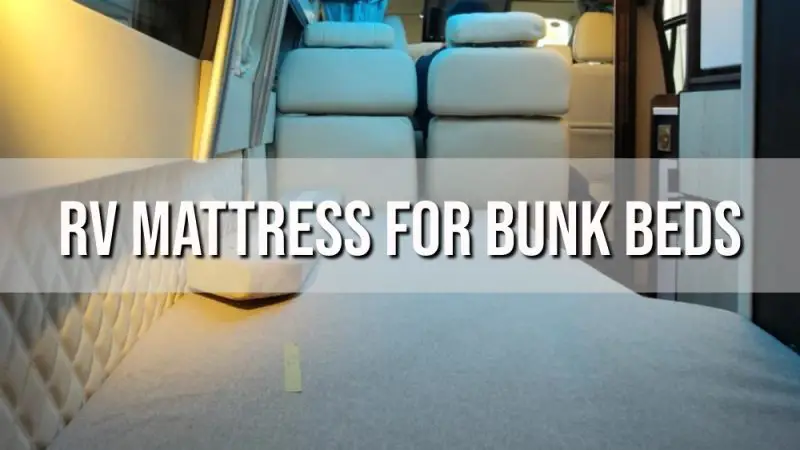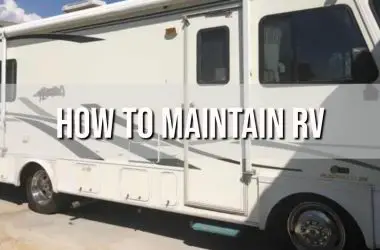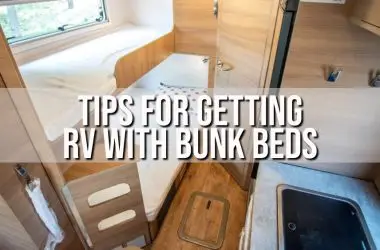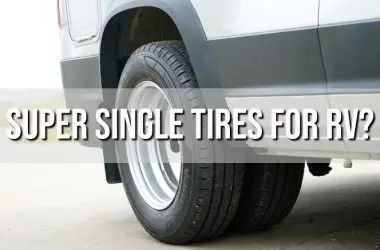To find the right RV mattress for bunk beds that provides cozy comfort for a good night’s rest, you need to consider the unique size requirements, materials, and design factors for RV bunk bed mattresses. The confined sleeping space of most recreational vehicle bunks requires specially-made mattresses that fit precisely within the limited dimensions. An RV often vibrates and shakes while driving, so the mattress also needs to be durable and supportive.
The key is finding a high-quality bunk bed mattress designed to maximize comfort in the compact RV environment. This guide covers how to select the ideal mattress for RV bunk beds based on size, thickness, materials, price, brand comparisons and other factors. We’ll also look at tips for customsizing mattresses, toppers, sheets and bedding for a perfect fit. Use this information to help choose mattresses ready for restful slumber during family travels.
Key Takeaways
- Look for custom short queen or RV twin size mattresses to precisely fit RV bunk dimensions.
- 6-8 inch thickness provides sufficient cushioning. Prioritize conforming memory foam.
- Match mattress firmness to sleeper preferences and needs for back support.
- Breathable bamboo, microfiber or cotton covers stay cool. Polyurethane resists moisture.
- Expect to pay $200 to $500 for a high-quality long-lasting RV bunk mattress.
- Measure carefully and find mattresses with exact sizing to properly fit the bunk bed space.
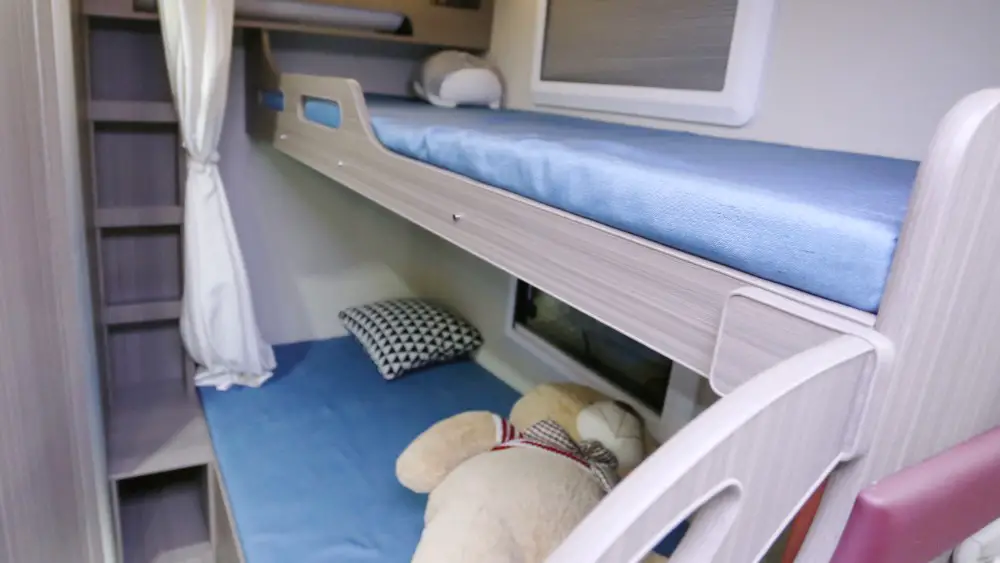
How Are RV Bunk Bed Mattress Sizes Different?
One of the first steps in choosing a new RV bunk mattress is to precisely measure the length and width of the available bunk bed space. RV bunks often require custom mattress sizes tailored shorter and narrower to properly fit. Here are some common bunk bed mattress sizes to look for:
- Short Queen – 60″ x 75″ for shorter compact bunk spaces
- RV Twin – Typically 28-30″ wide x 75″ long specifically for RV bunks
- RV XL Twin – For extra long bunks approximately 39″ x 80″
- Short King – Perfect split fit for opposing RV bunk beds
- Custom Cut – Any custom mattress dimensions you need for a flawless fit
Many standard home mattress sizes like queen and twin won’t correctly fit the confined RV bunk sleeping space. Be sure to verify your exact needed measurements before ordering. Manufacturers like Denver Mattress Company, Lippert Components and mattressmakers.com offer RV-specific mattresses cut to size. If you have to size down, look for models with thick comfort layers to prevent that “sinking in” feeling around the edges.
Determine the Right Thickness and Materials
Beyond precise sizing, also evaluate mattress thickness and material components when selecting the best RV bunk mattresses. Key guidelines include:
- Thickness – Look for a 6 to 8 inch profile for sufficient cushioning and support in the limited bunk space.
- Memory Foam – Conforming memory foam layers provide comfortable contouring and alleviate pressure points.
- Support Foam – Polyurethane or latex foam bases give shape and stability. High density prevents sagging.
- Covers – Breathable bamboo rayon or cotton covers stay cool. Polyurethane coated fabrics resist moisture and stains.
- Quality Materials – Higher grade foams and fabrics last longer despite heavy RV use and withstand humidity and heat.
Test different material combinations to find the right balance of plush comfort and adequate support for your needs. Softer foam can exacerbate sinkage on narrower mattresses.
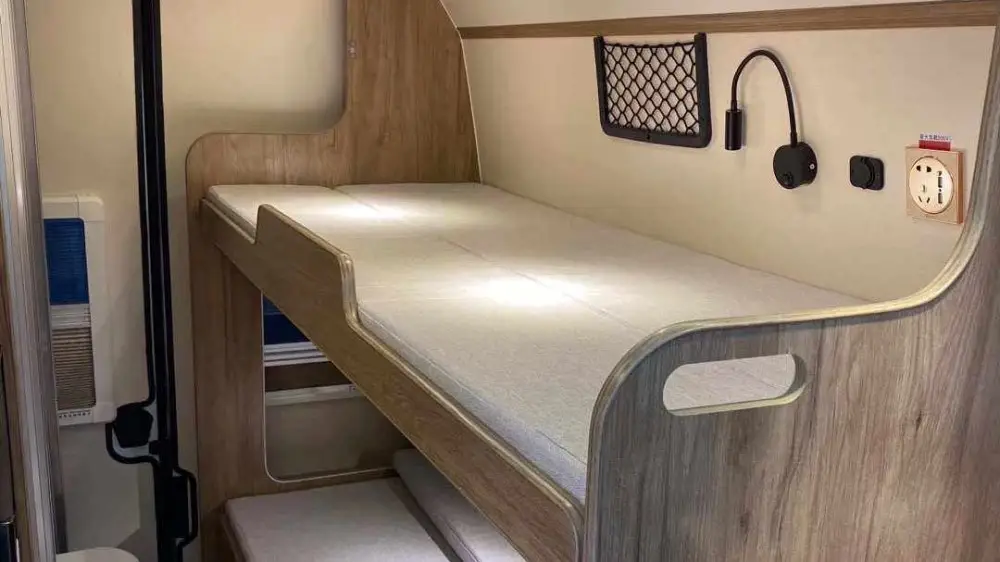
Choose the Best Firmness Level
Mattress firmness determines comfort and support. The right firmness for your RV bunk depends on:
- Personal Preference – Soft, medium or firm feel based on your sleeping style.
- Body Type – Lighter sleepers need less firmness; heavier people need more support.
- Sleep Position – Side sleepers do better on softer mattresses, back sleepers need firmer support.
- Bunk Design – Upper bunks can handle softer foam without sag. Firmer lower bunks prevent “falling in” feel.
- Age – Growing kids are better suited to medium firmness for developing spines.
Test different firmness levels when shopping to discover the ideal mattress feel for each bunk occupant based on their needs and preferences. Adjustable air mattresses allow custom firmness.
Compare Brands of Bunk Mattresses
Not sure where to start your bunk mattress search? Here are some top brands offering quality customizable RV bunk bed mattresses:
Denver Mattress – Custom cut mattresses in RV-friendly foams, shorts/twins
Lippert Components – Affordable RV mattress kits in cooling gel foam
Custom Mattress Makers – Made to order for any RV make and model
Wolf Corporation – Bunk mattresses for major RV brands like Jayco & Winnebago
Dynasty Mattress – Cooling gel and memory foam options, stain-resistant
Zinus – Low-cost bunk mattresses with high-density support foam
Lucid – Gel memory and latex RV mattresses with plush bamboo covers
Olee Sleep – Molded memory foam mattresses precisely sized for RV bunks
Comparing construction quality, materials, sizing accuracy and warranties can help narrow down the many bunk mattress choices.
Tips for Proper Sizing and Fit
One of the most important factors in selecting a replacement mattress for your RV’s bunk beds is achieving a precise sizing fit within the confined bunk space. RV bunk mattresses must conform exactly to the narrower and shorter dimensions typical in most recreational vehicles. Getting the size right ensures your new mattress will fit flawlessly into the bunk without uncomfortable gaps or awkward overhang. Here are some tips for nailing the ideal mattress sizing:
First, carefully measure the interior length, width and depth of the bunk bed platform using a tape measure. Don’t rely on the advertised mattress size or assume a standard twin or queen will fit. The actual interior bunk dimensions matter most. Measure side-to-side for width and top-to-bottom for length. For depth, measure from the bunk platform to the ceiling to ensure enough mattress thickness is allowed. Record your numbers.
When ordering, check with the manufacturer if the mattress dimensions can slightly exceed the bunk bed’s dimensions. Having an extra inch or two of mattress overhang on one or more sides can help reduce the sensation of “falling in” that occurs with undersized mattresses. A little overhang provides a sense of security.
If there are concerns about significant mattress compression over time, consider adding 1 to 2 inches to the width and length when ordering. This provides a buffer as the materials settle and compress. Just ensure the extra size doesn’t obstruct easy entrance and exit from the bunk. You want snug but not squeezed.
In situations where you have to size down to find RV-appropriate mattress dimensions, try to maximize thickness/depth as much as clearance allows to make up for the reduced length and width. At a minimum, aim for at least 6 inches thick but ideally 8 inches or more. This ensures some cushioning is still provided.
For maximum size flexibility, an adjustable air mattress may be the best solution for tricky bunks. Air mattresses allow you to inflate or deflate to precise dimensions required for an ideal fit. Like a customizable mattress alternative when uncommon sizes are involved. Just be sure to measure at your desired firmness.
Finding a mattress company that can manufacture a custom-cut mattress in any size you need is tremendously helpful for RVs. There are many mattress makers that specialize in boat, RV and other specialty vehicles. Choose a retailer that offers made-to-order mattresses in the exact size required.
After the custom-sized mattress arrives, carefully test it within the actual bunk beds before finalizing your purchase. Verify that the sizing is perfect and the mattress fits like a glove in the available bunk space. A trial run identifies any issues to correct before permanent installation.
Dialing in the exact mattress dimensions required for your particular RV bunks takes a bit of effort but pays dividends in maximized comfort over years of use. Precise sizing avoids uncomfortable gaps, slipping, and compression that ruins restful sleep. Follow these tips to achieve mattress sizing nirvana!

Consider Adding a Mattress Topper
For many RVers, adding a mattress topper can be a great way to inexpensively improve the comfort of existing RV bunk mattresses or fine tune the feel of a new mattress. Toppers provide an extra layer of plushness and support right on top of the mattress surface. Benefits of using mattress toppers on RV bunk beds include:
- Providing a softer overall surface feel without having to replace the entire bunk mattress. Foam or feather toppers gently cushion pressure points.
- Adding cooling relief during warm weather through use of breathable latex foam or gel-infused swirl foam toppers that promote airflow and dissipate heat.
- Increased pressure point relief and cushioning from conforming memory foam toppers or plush feather beds for aches and pains.
- The ability to customize mattress firmness by selecting different topper materials like soft memory foam or firmer bamboo.
- Increasing the overall mattress thickness in situations where the existing bunk mattress depth is inadequate or sagging. A thick topper compensates.
- Portability to use your comfortable preferred topper easily across different beds and bunks in the RV for maximum versatility.
When selecting a mattress topper for RV bunk beds, choose a size that fits the mattress dimensions precisely or opt for a slightly oversized version to minimize gaps. Standard topper thickness is 2 to 3 inches to adequately supplement the mattress. Overall, adding a high-quality mattress topper is an easy way to make a too firm mattress feel more luxurious.
Use Appropriately Sized Sheets and Bedding
Along with having properly sized RV mattresses and toppers, it’s important to outfit the bunk beds with well-fitted sheets and bedding linens. This finishes off the beds with a tidy wrinkle-free look. Since RV mattresses often deviate from standard mattress sizes, tailor-made RV sheets are required. Here are some tips:
- For hard-to-find mattress dimensions like short queen or RV twin, check specialty bedding stores that offer RV, boat, camper and caravan sheets. They stock sizes not found at regular stores.
- Bring the RV bunk mattresses’ exact length, width and depth measurements when sheet shopping to accurately match required sizes. Leaving guesswork often results in incorrect sizing.
- Look for fitted sheets with extra deep pockets that can snuggly accommodate today’s thicker mattresses and mattress toppers. Minimum 14 inch depth is good.
- For narrow yet extra long RV bunk mattresses, try fitted sheets sized for twin XL beds rather than standard twins that may be too short. The extra length is key.
- Coordinating bunk bed sheet sets can add color, patterns and visual interest to outfit the often confined bunk space.
- Mattress encasements that fully wrap around the mattress create a smooth surface underneath sheets for a wrinkle-free tidy look.
Taking the time to find fitted RV sheets purpose-made for the specific mattress dimensions ensures bedding layers properly onto the mattress without awkward gapping or looseness that causes frustration. Complete the look with plush blankets and comforters sized right for the bunks.
Typical Price Ranges for RV Bunk Mattresses
What can you expect to budget when purchasing a new mattress for your recreational vehicle’s bunk beds? Here are typical price ranges:
- $100 to $250 – Basic foam bunk mattresses with minimal features and thinner profiles.
- $250 to $400 – Medium-range models with thicker foam, gel infusion or memory foam.
- $400 to $600 – High-end mattresses from premium brands with maximum features and materials.
- $50 to $250 – Mattress toppers to improve existing mattress comfort and feel.
- $50 to $150+ – Fitted sheets sized specifically for RV bunk dimensions.
Consider how frequently the RV is used and bunk needs to determine if a luxury mattress is worthwhile or if budget foam does the trick. Prioritize quality for long-term durability either way.
Conclusion of Finding Right RV Mattress for Bunk Beds
Finding the ideal mattress is essential for truly restful, refreshing nights of sleep while traveling in your RV. Carefully measure your bunk bed dimensions, material preferences, comfort needs and budget to select the perfect mattress. Custom sizing, adjustable firmness and bunk-friendly construction ensure your mattress offers superior sleep on the road for years of family adventures ahead. Soon your bunkhouse will become the favorite space to unwind thanks to the comfort you create.
Frequently Asked Questions About RV Bunk Mattresses
Here are answers to some other common questions about selecting an ideal mattress for recreational vehicle bunk beds:
What is the standard size for RV bunk mattresses?
RV twin at approximately 28-30” wide x 75” long is the most common. Short queen at 60”x75” also fits some bunks. Always measure yours.
How thick should a good RV bunk mattress be?
Look for at least 6 inches thick and ideally 8 inches for adequate cushioning. The limited space still requires some thickness for comfort.
What firmness level works best for RV bunks?
Medium firmness around 6/10 provides the best blend of support and pressure relief for most bunk sleepers. Softer works for lightweight kids.
Which foam materials make the best bunk bed mattresses?
Breathable memory foam and latex foam provide contouring and alleviate pressure points on the narrow beds. Seek high-density support foam.
Do I need a special RV mattress cover?
Moisture-wicking, stain-resistant polyurethane or vinyl covers hold up best to humidity and spills. Bamboo rayon and cotton also resist odors.
Should I get a thicker mattress topper for my bunks?
Yes, adding a 2-3 inch premium topper is an easy way to improve comfort and extend mattress lifespan despite heavy use.
Is it hard to find sheets that fit RV bunk mattresses?
It can be tricky. Using your precise mattress measurements makes it easier to find specialty RV sheets that won’t gap or slip off.
How can I secure the mattress in the RV bunk?
Straps that attach around and under the mattress or non-slip pads keep it in place. Some bunks have built-in drawers to hold mattresses.
Will an RV mattress work on traditional beds at home?
Possibly, depending on thickness. Short queen and RV twins can transfer for kids or guest rooms. Maximum versatility is a bonus.


